City and island of Kérkyra (Corfu), Greece, Wednesday evening, 11 April 2001
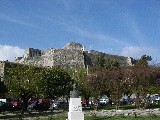
 This morning we breakfasted here in town before setting out in the car. The way to the parking place led us past one of the town's two Venetian-era forts (Stas and the children visited the other yesterday while I was on the laundry errand), and the yacht basin.
This morning we breakfasted here in town before setting out in the car. The way to the parking place led us past one of the town's two Venetian-era forts (Stas and the children visited the other yesterday while I was on the laundry errand), and the yacht basin.


 We spent the morning in Paleokastrítsa on the western coast of the island. This is traditionally identified with Homeric Scheria, the land of the Phaiakians, where Odysseus met young Nausicaä, and her parents Alcinoüs and Arete, and narrated his earlier adventures including those of the Lotus-eaters, Cyclops, Aeolus, Circe, the journey to the underworld, Scylla and Charybdis, the Sirens, and the cattle of the sun (Odyssey
Books 5-12). Scheria is probably best identified with pure utopian fantasy, but this is certainly a gorgeous place. (These panoramic views of the double or even triple harbor are each imperfectly spliced together from multiple exposures.)
We spent the morning in Paleokastrítsa on the western coast of the island. This is traditionally identified with Homeric Scheria, the land of the Phaiakians, where Odysseus met young Nausicaä, and her parents Alcinoüs and Arete, and narrated his earlier adventures including those of the Lotus-eaters, Cyclops, Aeolus, Circe, the journey to the underworld, Scylla and Charybdis, the Sirens, and the cattle of the sun (Odyssey
Books 5-12). Scheria is probably best identified with pure utopian fantasy, but this is certainly a gorgeous place. (These panoramic views of the double or even triple harbor are each imperfectly spliced together from multiple exposures.)
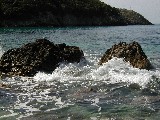
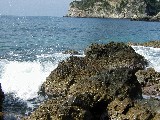 One feature (besides the harbor itself) that does seem right for Scheria is these rocks, which are just the right sort to rip the skin off your hands if you attempt to hang on to them while being pushed and pulled by a heavy surf. On the other hand, there seems to be no river anywhere near for Odysseus to pray to and swim up, or for Princess Nausicaä to do the palace laundry in.
One feature (besides the harbor itself) that does seem right for Scheria is these rocks, which are just the right sort to rip the skin off your hands if you attempt to hang on to them while being pushed and pulled by a heavy surf. On the other hand, there seems to be no river anywhere near for Odysseus to pray to and swim up, or for Princess Nausicaä to do the palace laundry in.
 Of course the children enjoyed the time at the beach.
Of course the children enjoyed the time at the beach.
Litóhoro, Pieria, Greece, Easter Sunday, 15 April 2001.
We were just exactly in time for a very nice and rather faster ferry back from Corfu to Igoumenítsa Thursday morning. We found an inexpensive hotel in Yánnina, but by that time it was pouring rain, which continued into the night, and shut down our planned sightseeing completely. In the morning the weather was fine and we attempted to visit Dodona, but it was closed for Good Friday. Expecting we would thenceforth meet only more of the same, we decided just to head back to Litóhoro, a day earlier than originally planned.
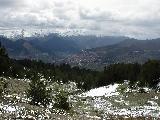 We stopped for lunch and to pick up a sample of the local weaving and embroidery at the beautiful Epirot mountain town of Métsovo, shown here from a distance, looking back and down from the road east to Tríkala. This same road through the Píndos mountain range topped out at 1690 meters, over a mile high, just a little further east.
We stopped for lunch and to pick up a sample of the local weaving and embroidery at the beautiful Epirot mountain town of Métsovo, shown here from a distance, looking back and down from the road east to Tríkala. This same road through the Píndos mountain range topped out at 1690 meters, over a mile high, just a little further east.
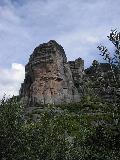
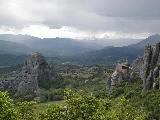 On the way down from the pass we stopped to gawk a little at the Meteora ("sky-things," the same ancient word used by Plato and Aristophanes for subjects of cosmological study and speculation). These towering rock formations are in many cases surmounted by monasteries, set there presumably for the sake of monastic seclusion, though in one of modern life's ironies this striking setting has turned the whole neighborhood into a mecca both for tourists and for rock-climbing enthusiasts.
On the way down from the pass we stopped to gawk a little at the Meteora ("sky-things," the same ancient word used by Plato and Aristophanes for subjects of cosmological study and speculation). These towering rock formations are in many cases surmounted by monasteries, set there presumably for the sake of monastic seclusion, though in one of modern life's ironies this striking setting has turned the whole neighborhood into a mecca both for tourists and for rock-climbing enthusiasts.

 Although the ecclesiastical foundations on the pinnacles are of a monastic rather than pastoral kind, neighbors at their feet still follow a pastoral vocation.
Although the ecclesiastical foundations on the pinnacles are of a monastic rather than pastoral kind, neighbors at their feet still follow a pastoral vocation.
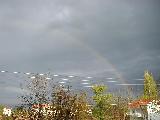 After a day of astonishingly varied weather, our neighbor Zeus sent his messenger Iris to welcome us back to Litóhoro with a full-arc rainbow.
After a day of astonishingly varied weather, our neighbor Zeus sent his messenger Iris to welcome us back to Litóhoro with a full-arc rainbow.
previous entry
next entry
main/ToC page


 We spent the morning in Paleokastrítsa on the western coast of the island. This is traditionally identified with Homeric Scheria, the land of the Phaiakians, where Odysseus met young Nausicaä, and her parents Alcinoüs and Arete, and narrated his earlier adventures including those of the Lotus-eaters, Cyclops, Aeolus, Circe, the journey to the underworld, Scylla and Charybdis, the Sirens, and the cattle of the sun (Odyssey
Books 5-12). Scheria is probably best identified with pure utopian fantasy, but this is certainly a gorgeous place. (These panoramic views of the double or even triple harbor are each imperfectly spliced together from multiple exposures.)
We spent the morning in Paleokastrítsa on the western coast of the island. This is traditionally identified with Homeric Scheria, the land of the Phaiakians, where Odysseus met young Nausicaä, and her parents Alcinoüs and Arete, and narrated his earlier adventures including those of the Lotus-eaters, Cyclops, Aeolus, Circe, the journey to the underworld, Scylla and Charybdis, the Sirens, and the cattle of the sun (Odyssey
Books 5-12). Scheria is probably best identified with pure utopian fantasy, but this is certainly a gorgeous place. (These panoramic views of the double or even triple harbor are each imperfectly spliced together from multiple exposures.)

 This morning we breakfasted here in town before setting out in the car. The way to the parking place led us past one of the town's two Venetian-era forts (Stas and the children visited the other yesterday while I was on the laundry errand), and the yacht basin.
This morning we breakfasted here in town before setting out in the car. The way to the parking place led us past one of the town's two Venetian-era forts (Stas and the children visited the other yesterday while I was on the laundry errand), and the yacht basin.








